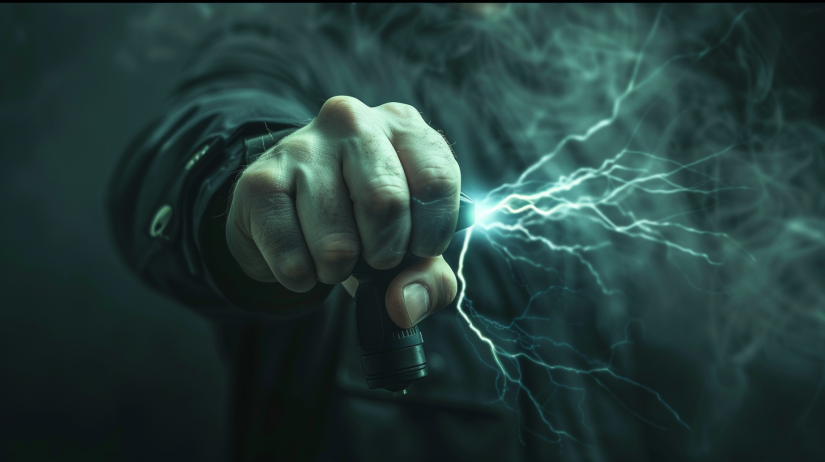
free shipping on orders over $25
We’re having a sale on all our products. Enter your email below to be notified about future sales.


In a world where you can harness lightning bolts in your hand, stun guns have become the top choice for personal safety. But before you rush to grab your own electric protector, it’s important to grasp what lies beneath the surface spark.
Stun guns are a popular tool for self-defense, delivering a high-voltage electric shock to temporarily incapacitate an attacker. You might be curious how such a small device can deliver such a strong shock. It all comes down to the technology inside that transforms low-voltage battery power into a high-voltage shock. This shock doesn’t cause lasting harm but is enough to halt someone in their tracks, giving you a chance to get away.
When you hold a stun gun, you’re carrying a device that can release thousands of volts. But don’t worry, it’s made with your safety in mind. The current is high, but the amperage is low, which is why it can stun without causing serious harm. It’s important to understand this balance; that’s what makes stun guns effective yet not deadly.
Stun guns are easy to use. You simply press it against the attacker and trigger the shock. But keep in mind, the effectiveness can vary. Factors like the shock duration and the attacker’s clothing can affect how well the stun gun works. It’s not a magic tool, but in many cases, it can give you that important moment to escape. Always remember, the main goal is to get away from danger, not to get into a fight.
Let’s dive into the interesting history of stun guns, which have been around for much longer than you might expect. Stun guns work by delivering an electric shock, but how did this concept come about, and what is their story? Let’s find out!
In the 18th century, people first started exploring the use of electricity, which eventually led to the creation of electroshock devices. However, it wasn’t until the 20th century that these ideas developed into tools for self-defense and law enforcement. Over time, technology has improved these devices, making them smaller and more effective than before.
To make this history more digestible, here’s a brief timeline:
| Year | Milestone |
|---|---|
| 1780 | Discovery of “animal electricity” by Luigi Galvani, laying the groundwork for understanding electrical currents in living beings. |
| 1930s | Invention of the cattle prod, marking the first practical use of electric shock for control. |
| 1960s | Development of the Taser, a significant leap forward in non-lethal self-defense technology. |
| 1990s | Introduction of compact, consumer-friendly stun guns, making personal safety devices more accessible to the public. |
This table highlights key moments in the development of electroshock technology, showing you just how far we’ve come in understanding and utilizing electricity for safety.
Stun guns work by using electrical shock to incapacitate an attacker without causing permanent harm. When you press the stun gun against an assailant and activate it, the device releases a high-voltage, low-amperage charge. This charge disrupts the attacker’s muscles, stopping them in their tracks and making them unable to harm you. Understanding how stun guns function can boost your understanding of personal defense tools.
When a stun gun is used, it sends electricity through the attacker’s body by targeting their nervous system. This causes the muscles to receive rapid signals, which confuses the body and temporarily stops it from moving. Even though the voltage is high, the amperage is kept low to prevent the shock from being deadly. Remember, it’s the amperage, not the voltage, that could potentially be lethal.
Stun guns work by directly touching the attacker, so you need to be near enough to make contact. This design focuses on keeping you safe right away and offers a way to protect yourself without using deadly methods. Remember, the main aim is to get away from danger, not to get into a long fight.
Stun guns can offer valuable insights into personal defense when you explore how they function. It’s also essential to look at the laws that govern their use worldwide. Regulations can vary significantly, affecting where and how you can carry and use these devices. Let’s quickly go through them:
Understanding these legal considerations is crucial for responsibly integrating stun guns into your personal safety plan.
Considering the potential for injury, it’s crucial to weigh the safety and risks associated with using stun guns for self-defense.
When you’re contemplating incorporating a stun gun into your personal safety arsenal, it’s important to understand both its effectiveness and its limitations. Stun guns can incapacitate an attacker temporarily, giving you a critical window to escape. However, their effectiveness can vary based on the situation and the individual targeted. Factors such as clothing thickness, distance, and the specific model of stun gun can all impact performance.
You should also be aware of the physical effects stun guns have on the human body. While they’re designed to be non-lethal, they can cause pain, muscle contractions, and disorientation. In rare cases, there may be more serious health implications, especially for individuals with pre-existing heart conditions or other vulnerabilities.
Moreover, the psychological impact of being prepared to use such a device on another person shouldn’t be underestimated. Handling a stun gun requires a level of responsibility and readiness to face potential moral and ethical dilemmas.
Lastly, while stun guns provide a means of self-defense, they’re not foolproof. Misuse or reliance on a stun gun alone without considering other safety strategies could put you at risk. It’s vital to combine its use with situational awareness and other precautionary measures to ensure your safety.
A lot of folks mix up stun guns with Tasers, but it’s important to know the clear differences between these two self-defense gadgets. Even though both can help keep you safe from an attacker, understanding what makes them unique can assist you in picking the right one for your personal safety.
Here are the key differences:
Understanding these differences can be vital in making an informed decision about your personal safety strategy.
When picking the perfect stun gun model, it all comes down to knowing your personal security needs and the features each type offers. You need to think through your choices, looking at things like size, power, and extra features. It’s not just about the strongest voltage; it’s about what suits your life and makes you feel safe.
If you’re often out late, a compact model that easily slips into your pocket or purse might be your best bet. These smaller devices are discreet but still pack a punch. On the other hand, if you’re looking for something that feels more secure in your hand, larger models with wrist straps and grip casings ensure you won’t lose hold in a scuffle.
Don’t overlook features like built-in flashlights or alarms. A bright light can disorient an attacker, giving you a crucial moment to act, while a loud alarm might deter them altogether or draw attention for help.
So you’ve picked out the perfect stun gun model. Now, let’s dive into how to properly maintain and use it for maximum effectiveness. Keeping your device in top condition ensures it’s always ready when you need it. And knowing how to wield it effectively can truly make a difference in a critical situation. Here’s a guide to help you get the most out of your stun gun:
By following these tips and guidelines, you can ensure that your stun gun is always ready for action and that you can use it effectively when needed. Stay safe and prepared!
You’re asking if stun guns work on big animals like dogs or bears for self-defense. Well, they might deter dogs, but they’re not reliable against bears. You’re better off with bear spray in those situations.
You’re wondering how rain or snow impacts stun gun use. Well, wet conditions can reduce effectiveness and increase risk, so it’s crucial to handle them with extra caution in such environments to ensure safety.
You might wonder if being hit by a stun gun leaves lasting psychological scars. Studies suggest survivors can face trauma, anxiety, and stress-related disorders, indicating there are indeed long-term psychological effects to consider.
If you’ve got a medical condition like epilepsy or a pacemaker, you should think twice before using a stun gun for self-defense. It’s best to consult with a doctor to weigh the risks.
Walking on eggshells, you’ll find that having a stun gun at home might make your kids or teens more cautious. They’re likely to develop a heightened awareness of safety and potentially more responsible behavior.
2 Responses